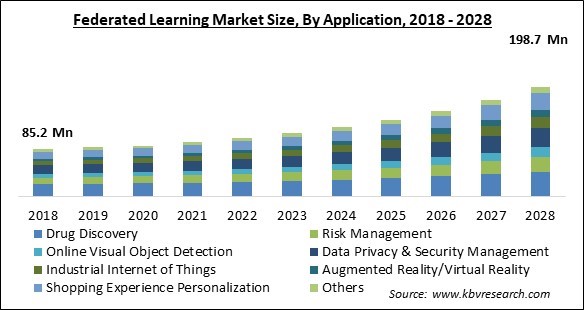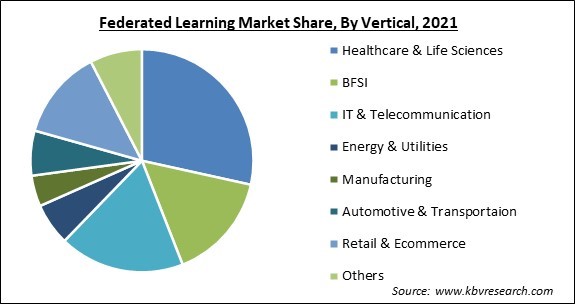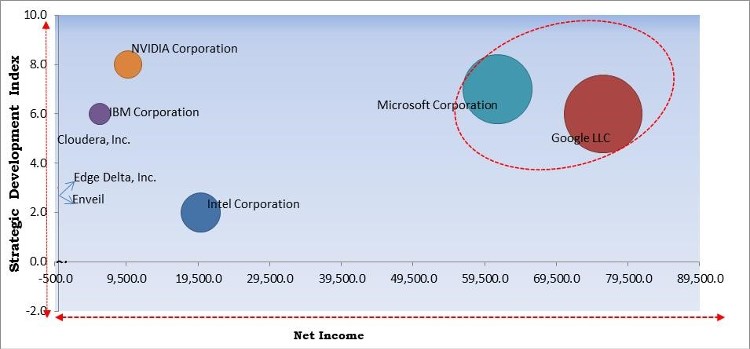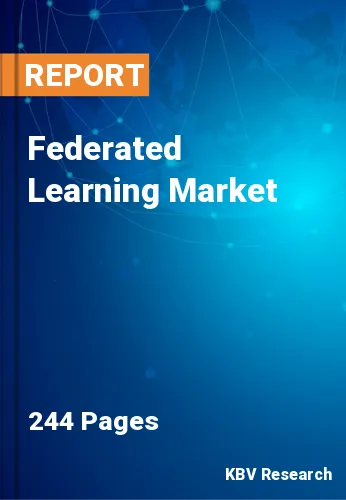The Global Federated Learning Market size is expected to reach $198.7 Million by 2028, rising at a market growth of 11.1% CAGR during the forecast period.
Federated learning can be described as a machine learning approach that distributes an algorithm among a number of decentralized end devices or servers that each have local data samples. This strategy differs from standard centralized machine learning methods, which store all local datasets on a single server. Additionally, this technique ensures that the local data samples are disseminated to the server in the same way. Federated learning can be utilized to build consumer behavior models from the data pool of smartphones without revealing personal information, like for next-word prediction, voice recognition, facial identification, and other applications. Federated learning enables various vendors to develop a shared machine learning algorithm without sharing data, allowing crucial issues like data access rights, data privacy and security, and the capacity to access heterogeneous data to be addressed. Defense, telecommunications, and medicines are among the businesses that can leverage federated learning to optimize their operations.
The growing need for improved data protection and privacy, as well as the increasing requirement to adapt data in real-time to optimize conversions automatically are driving the advancement of the federated learning solutions market. Moreover, by retaining data on devices, these solutions assist organizations in leveraging machine learning models, boosting the federated learning market forward. Furthermore, the ability to provide predictive features on the latest smart devices without compromising the consumer experience or divulging private information is providing lucrative opportunities for the federated learning market to develop throughout the coming years.
Federated learning can be described as a machine learning approach that distributes an algorithm among a number of decentralized end devices or servers that each have local data samples. This strategy differs from standard centralized machine learning methods, which store all local datasets on a single server. Additionally, this technique ensures that the local data samples are disseminated to the server in the same way. Federated learning can be utilized to build consumer behavior models from the data pool of smartphones without revealing personal information, like for next-word prediction, voice recognition, facial identification, and other applications. Federated learning enables various vendors to develop a shared machine learning algorithm without sharing data, allowing crucial issues like data access rights, data privacy and security, and the capacity to access heterogeneous data to be addressed. Defense, telecommunications, and medicines are among the businesses that can leverage federated learning to optimize their operations.
The growing need for improved data protection and privacy, as well as the increasing requirement to adapt data in real-time to optimize conversions automatically are driving the advancement of the federated learning solutions market. Moreover, by retaining data on devices, these solutions assist organizations in leveraging machine learning models, boosting the federated learning market forward. Furthermore, the ability to provide predictive features on the latest smart devices without compromising the consumer experience or divulging private information is providing lucrative opportunities for the federated learning market to develop throughout the coming years.

COVID-19 is an unprecedented global public health crisis that has impacted practically every business, and its long-term repercussions significantly impacted various markets in numerous countries all over the world. In addition, governments across the world imposed lockdown in their countries in order to regulate the diffusion of the hazardous COVID-19 infection. These lockdowns caused major disruptions in the worldwide supply chain of all the products and services due to travel restrictions. The infection was rapidly spreading all over the world, creating economic stagnation and compelling thousands of employees to work from home. However, artificial intelligence, as well as machine learning, were majorly used to forecast and investigate the spread of potential data alarms in several countries all over the world.
Due to federated learning, the manner in which ML approaches are offered is evolving. Companies are increasing their efforts on performing a thorough investigation of federated learning. Using federated learning, companies may reinforce their existing algorithms and improve their AI applications. The demand for improved learning is increasing among both gadgets and companies. In the healthcare field, federated learning could help healthcare personnel deliver high-quality outcomes while also accelerating drug development. For example, FADNet, a new peer-to-peer technique, is a remedy for centralized learning inadequacies.
Federated learning, rather than keeping data on a single computer or data mart, stores data on original sources, like smartphones, manufacturing detection equipment, other end devices, and machine learning machines are trained on the go. This aids in decision-making before being sent back to a centralized computer. For example, federated learning is widely used in the finance sector for debt risk assessments. Typically, banks use whitelisting processes to keep customers out of the Federal Reserve System based on their credit card information. Risk assessment variables, like taxation and reputation, may be employed by working with other financial institutions and eCommerce businesses.
Many businesses encounter a significant impediment when integrating machine learning into existing workflows due to a scarcity of trained people, particularly IT specialists. Because federated learning systems are a new concept, it is difficult for personnel to grasp and execute them. Recruiting and maintaining technical skills became a major concern for several firms due to a scarcity of skilled candidates to incorporate federated learning projects that include difficult methodologies, such as machine learning. As an organization, they must develop a growing range of talents and job titles. Organizations, for example, require experts that can administer and comprehend the current federated learning architecture connected with the installation and maintenance of machine learning algorithms.

Based on Application, the market is segmented into Drug Discovery, Risk Management, Online Visual Object Detection, Data Privacy & Security Management, Industrial Internet of Things, Augmented Reality/Virtual Reality, Shopping Experience Personalization, and Others. In 2021, the industrial internet of thigs segment procured a substantial revenue share of the federated learning market. Sensors are used in modern IoT networks, like wearable gadgets, autonomous vehicles, and smart homes, to gather and respond to the data in real-time. To operate properly, a fleet of autonomous vehicles, for example, may require an updated model of construction, traffic, or pedestrian behavior. Due to privacy concerns and the restricted connectivity of each device, constructing aggregate models in these cases may be challenging. Federated learning approaches make it possible to train models that can respond to changes in these systems quickly while respecting users' privacy. This factor is segmenting the growth of this segment.
Based on Vertical, the market is segmented into Healthcare & Life Sciences, BFSI, IT & Telecommunication, Energy & Utilities, Manufacturing, Automotive & Transportation, Retail & Ecommerce, and Others. In 2021, the healthcare & life sciences segment witnessed the largest revenue share of the federated learning market. The increasing growth of this segment is attributed to the fact that healthcare and life sciences industry is constantly under pressure to improve the quality of services it provides to people. The amount of unstructured data in the healthcare industry is increasing significantly. Access to unstructured data, like medical device output, imaging reports, and lab findings, is ineffective in improving patient health. Pharmaceutical firms are included in the healthcare and life sciences category. With many research initiatives, consortiums, and implementations, the utilization of federated learning technologies is expediting in the healthcare and life sciences sectors.
| Report Attribute | Details |
|---|---|
| Market size value in 2021 | USD 98.2 Million |
| Market size forecast in 2028 | USD 198.7 Million |
| Base Year | 2021 |
| Historical Period | 2018 to 2020 |
| Forecast Period | 2022 to 2028 |
| Revenue Growth Rate | CAGR of 11.1% from 2022 to 2028 |
| Number of Pages | 244 |
| Number of Tables | 363 |
| Report coverage | Market Trends, Revenue Estimation and Forecast, Segmentation Analysis, Regional and Country Breakdown, Competitive Landscape, Companies Strategic Developments, Company Profiling |
| Segments covered | Application, Vertical, Region |
| Country scope | US, Canada, Mexico, Germany, UK, France, Russia, Spain, Italy, China, Japan, India, South Korea, Singapore, Malaysia, Brazil, Argentina, UAE, Saudi Arabia, South Africa, Nigeria |
| Growth Drivers |
|
| Restraints |
|
Based on Regions, the market is segmented into North America, Europe, Asia Pacific, and Latin America, Middle East & Africa. In 2021, Europe accounted for the largest revenue share of the federated learning market. Patient data and risk analysis, precision medicine, lifestyle management, and monitoring, medical imaging and diagnostics, drug development, virtual assistant, inpatient care and hospital management, wearable, and research are some of the applications in the federated learning industry for healthcare. The drug development process is time-consuming, as it necessitates the analysis of massive amounts of bioscience data, such as patents, genetic data, and a significant number of papers uploaded daily throughout all biomedical journals as well as databases.
Free Valuable Insights: Global Federated Learning Market size to reach USD 198.7 Million by 2028

The major strategies followed by the market participants are Product Launches. Based on the Analysis presented in the Cardinal matrix; Microsoft Corporation and Google, Inc. are the forerunners in the Federated Learning Market. Companies such as Nvidia Corporation, IBM are some of the key innovators in the Market.
The market research report covers the analysis of key stake holders of the market. Key companies profiled in the report include IBM Corporation, Microsoft Corporation, Intel Corporation, Google LLC, Cloudera, Inc., NVIDIA Corporation, Edge Delta, Inc., DataFleets Ltd. (LiveRamp Holdings, Inc.), Enveil, and Secure AI Labs, Inc.
By Application
By Vertical
By Geography
The global federated learning market size is expected to reach $198.7 Million by 2028.
Enhanced data privacy in numerous applications are driving the market in coming years, however, scarcity of skilled technical professionals growth of the market.
IBM Corporation, Microsoft Corporation, Intel Corporation, Google LLC, Cloudera, Inc., NVIDIA Corporation, Edge Delta, Inc., DataFleets Ltd. (LiveRamp Holdings, Inc.), Enveil, and Secure AI Labs, Inc.
The expected CAGR of the federated learning market is 11.1% from 2022 to 2028.
The Drug Discovery segment acquired maximum revenue share in the Global Federated Learning Market by Application in 2021, thereby, achieving a market value of $43,969 Thousands by 2028.
The Europe is the fastest growing region dominated the Global Federated Learning Market by Region in 2021, and would continue to be a dominant market till 2028.
Our team of dedicated experts can provide you with attractive expansion opportunities for your business.

